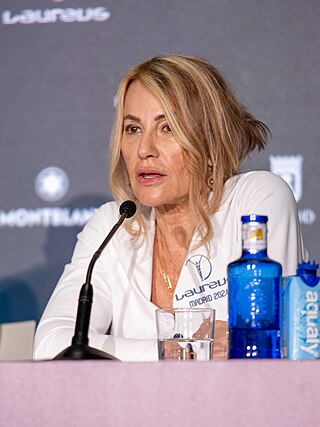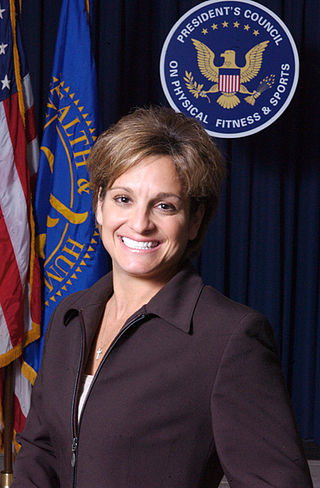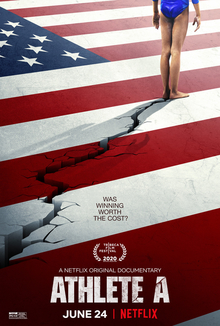
Nadia Elena Comăneci Conner is a Romanian retired gymnast. She is a five-time Olympic gold medalist, all in individual events. In 1976, at the age of 14, Comăneci was the first gymnast to be awarded a perfect score of 10.0 at the Olympic Games. At the same Games, she received six more perfect 10s for events en route to winning three gold medals. At the 1980 Summer Olympics in Moscow, she won two more gold medals and achieved two more perfect 10s. During her career, she won nine Olympic medals and four World Artistic Gymnastics Championship medals.

Mary Lou Retton is an American retired gymnast. At the 1984 Summer Olympics in Los Angeles, she won a gold medal in the individual all-around competition, as well as two silver medals and two bronze medals.

Béla Károlyi is a former gymnastics coach; he is an ethnic Hungarian Romanian-American. Early in his coaching career he developed the Romanian centralized training system for gymnastics. One of his earliest protégés was Nadia Comăneci, the first Olympic Games gymnast to be awarded a perfect score. Living under the dictatorship of Nicolae Ceaușescu, Károlyi frequently clashed with Romanian officials. He and his wife defected to the United States in 1981.

Jamie Annette Dantzscher is an American former artistic gymnast. She was a member of the bronze medal-winning American team at the 2000 Olympics in Sydney.
Julissa D'Anne Gomez was an American gymnast whose rapid rise through the ranks of elite gymnastics in the mid-1980s was cut short by a vaulting accident in 1988 that left her a quadriplegic. She eventually died from her injury. She was being coached by Al Fong, and had previously been coached by Bela Karolyi.

Márta Károlyi is a Romanian-Hungarian-American gymnastics coach and the former national team coordinator for USA Gymnastics. She and her husband, Béla, are ethnic Hungarians from Transylvania, Romania, who trained athletes in Romania, including Nadia Comăneci, before defecting to the United States in 1981. Béla and Márta Károlyi have trained nine Olympic champions, fifteen world champions, sixteen European medalists and many U.S. national champions, including Comăneci, Mary Lou Retton, Betty Okino, Kerri Strug, Teodora Ungureanu, Phoebe Mills, Kim Zmeskal, and Dominique Moceanu.
Christina "Christy" Renée Henrich was an American artistic gymnast. Her death from anorexia nervosa at age 22 led to major reforms in the way women's gymnastics is covered on television and in the news media. She was coached by Al Fong.
Katherine "Kathy" Johnson Clarke is an American sports commentator and former artistic gymnast. Johnson was one of the first American gymnasts to win a major international medal, known for her longevity and tenacity in the sport.

United States of America Gymnastics is the national governing body for gymnastics in the United States. Established in 1963 as the U.S. Gymnastics Federation (USGF), USA Gymnastics is responsible for selecting and training national teams for the Olympic Games and World Championships. The revised 2018 mission of USA Gymnastics is focused on "creating a culture that empowers and supports its athletes and focuses on its highest priority, the safety and well-being of the athletes." USAG sets the rules and policies that govern the sport of gymnastics, including "promoting and developing gymnastics on the grassroots and national levels, as well as a safe, empowered and positive training environment, and serving as a resource center for members, clubs, fans and gymnasts throughout the United States."

Valeri Viktorovich Liukin is a Kazakh-American retired artistic gymnast currently working as a gymnastics coach. Representing the former Soviet Union, Liukin was the 1988 Olympic champion in the team competition and individually on the horizontal bar, and Olympic silver medalist in the all-around and the parallel bars.
Kristie Phillips-Bannister, formerly known as Kristie Phillips, is a retired American elite gymnast. The 1987 senior U.S. National Champion and one of the American team's strongest and most visible competitors in the mid-1980s, Phillips was considered to be one of the front-runners for the 1988 U.S. Olympic team. By the Olympic Trials in 1988, however, she had endured several coaching changes and a growth spurt, and was only named second alternate to the team. She went on to participate in competitive cheerleading in college and has since enjoyed successful careers as an actress, stunt woman, coach and gymnastics club owner.
Carol Michelle "Chelle" Stack is a former gymnast. She competed for the United States national team at the 1988 Seoul Summer Olympics. She is currently active as a brevet rated judge at US national gymnastics competitions.

The United States women's national artistic gymnastics team represents the United States in FIG international competitions.
The USA Gymnastics National Team Training Center at Karolyi Ranch or simply Karolyi Ranch in unincorporated Walker County, Texas, southeast of Huntsville, was a gymnastics camp facility which was the site of the main training center for the United States women's national gymnastics team, located 70 miles (110 km) north of Houston within the Sam Houston National Forest. From 2001 to 2018, it was the USA Gymnastics' national training facility for women's artistic, trampoline, and rhythmic gymnastics disciplines.
Great American Gymnastics Express, known also as GAGE Center or GAGE, is an American artistic gymnastics academy, located in Blue Springs, Missouri.

Stephen D. Penny Jr. is an American businessman and sports administrator. He was president and CEO of USA Gymnastics (USAG) from 2005 until 2017, and is a key figure in the USA Gymnastics sex abuse scandal.

The USA Gymnastics sex abuse scandal relates to the sexual abuse of hundreds of gymnasts—primarily minors—over two decades in the United States, starting in the 1990s. It is considered the largest sexual abuse scandal in sports history.
Erica Stokes is a former United States gymnast. Stokes trained with Bela Karolyi in Houston, Texas.

Athlete A is a 2020 American documentary film about the USA Gymnastics sex abuse scandal. Directed by Bonni Cohen and Jon Shenk, the documentary follows a team of investigative journalists from The Indianapolis Star as they broke the story of doctor Larry Nassar sexually assaulting young female gymnasts and the subsequent allegations that engulfed USA Gymnastics (USAG) and its then-CEO Steve Penny. It was released on June 24, 2020, by Netflix.
Dianne Patrice Durham was an American artistic gymnast. In 1983, she won the all-around senior title at the women's US National Championships, becoming the first African American athlete to do so. She was Béla and Márta Károlyi's first elite athlete in the United States, helping establish their coaching credentials outside of the state-sponsored program of their native Romania, and trained with Mary Lou Retton, who called Durham her "best competition". After injuries and competition stipulations prevented her from competing in the 1984 Summer Olympics, Durham retired from competition in 1985. She later ran the Skyline Gymnastics school in Chicago.









